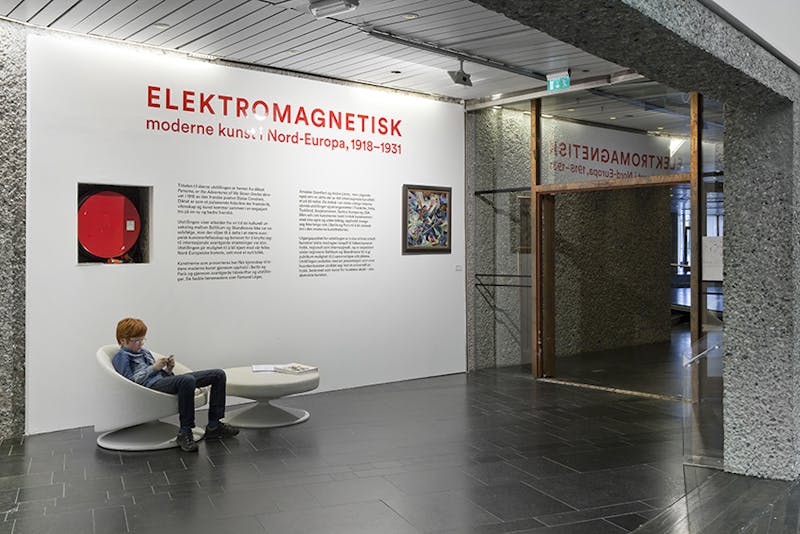Electro-magnetic
Modern Art in Northern Europe, 1918-1931

Installation shot: Øystein Thorvaldsen / Henie Onstad Archive
The title of the exhibition is taken from the 1918 poem La Panama ou les Aventures de mes Sept Oncles (Panama, or the Adventures of My Seven Uncles) by Blaise Cendrars. The poem describes a spirit of an age marked by revolution, restlessness and desire to explore, but also an era of optimism inspired by science and technology in rapid development.
Cross-pollination between the Baltic and Scandinavian countries is taken for granted today. This exhibition focuses on a time when things were different, but when there was nevertheless a willingness to participate in a larger, European fellowship of artists and a great need to connect with international movements of art. This exhibition gives visitors the opportunity to become acquainted with a shared Northern European history, seen from a new perspective.
The artists presented here became familiar with modern art through stays in Berlin and Paris, and avant-garde journals and exhibitions worldwide. They had teachers like Fernand Léger, Amédée Ozenfant and André Lhote, but also played an active part themselves in the international art world in the 20th century. They participated in a number of important exhibitions and events in France, Italy, Germany, the Soviet Union, Central Europe and the USA. However, even if the artists quickly captured the international art scene with their own and unique contributions, many of them were not included in the main narrative of modern art, and therefore are not well recognized today.
The starting point of the exhibition is to show how each individual artist contributed to the art scene of the time, regionally and internationally, with his or her own unique input. The artists in the exhibition are organized under the rubric of the Baltic and Scandinavian regions they came from to give the public the opportunity to compare the various expressions. The exhibition concludes with a presentation showing how art developed towards a universal expression, described as “art for art's sake” – a self sufficient and non-referential abstract art consisting of planes and colors.
- Electromagnetic – Modern Art in Northern Europe, 1918-1931
-
Gøsta Adrian-Nilsson, Arnold Akberg, Aleksandra Beļcova, Christian Berg, Edmond Arnold Blumenfeldt, Otto Gustaf Carlsund, Franciska Clausen, Vladas Drėma, Carl Theodor Dreyer, Viking Eggeling, Ģederts Eliass, Juan Gris, Thorvald Hellesen, Vytautas Kairiūkštis, Jēkabs Kazaks, Ragnhild Keyser, Gustavs Klucis, Aleksander Krims, Ragnhild Kaarbø, Märt Laarman, Le Corbusier (Charles-Édouard Jeanneret-Gris), Fernand Léger, André Lhote, Ludolf Liberts, Jānis Liepiņš, Jacques Lipchitz, Vilhelm Lundstrøm, Knut Lundström, Eduard Ole, Erik A. Olson, Henrik Olvi, Amédée Ozenfant, Felix Randel, Hans Richter, Jaan Siirak, Oto Skulme, Uga Skulme, Niklāvs Strunke, Romans Suta, Erasts Šveics, Esaias Thorén, Valdemārs Tone, Jaan Vahtra, Moï Ver and Charlotte Wankel.
-
Gladys Fabre, Tone Hansen and Gerd Elise Mørland.
Installation shots
-
![Elektromagnetisk MG 5900]()
Installation shot: Øystein Thorvaldsen / Henie Onstad Archive
-
![Elektromagnetisk MG 5953]()
Installation shot: Øystein Thorvaldsen / Henie Onstad Archive
-
![Elektromagnetisk MG 5947]()
Installation shot: Øystein Thorvaldsen / Henie Onstad Archive
-
![Elektromagnetisk MG 5941]()
Installation shot: Øystein Thorvaldsen / Henie Onstad Archive
-
![Elektromagnetisk MG 5935]()
Installation shot: Øystein Thorvaldsen / Henie Onstad Archive
-
![Elektromagnetisk MG 5930]()
Installation shot: Øystein Thorvaldsen / Henie Onstad Archive
-
![Elektromagnetisk MG 5915]()
Installation shot: Øystein Thorvaldsen / Henie Onstad Archive
-
![Elektromagnetisk MG 5904]()
Installation shot: Øystein Thorvaldsen / Henie Onstad Archive
-
![Elektromagnetisk MG 5988]()
Installation shot: Øystein Thorvaldsen / Henie Onstad Archive
-
![Elektromagnetisk MG 5984]()
Installation shot: Øystein Thorvaldsen / Henie Onstad Archive
-
![Elektromagnetisk MG 5981]()
Installation shot: Øystein Thorvaldsen / Henie Onstad Archive
-
![Elektromagnetisk MG 5980]()
Installation shot: Øystein Thorvaldsen / Henie Onstad Archive
-
![Elektromagnetisk MG 5959]()
Installation shot: Øystein Thorvaldsen / Henie Onstad Archive
-
![Elektromagnetisk MG 5956]()
Installation shot: Øystein Thorvaldsen / Henie Onstad Archive
-
![Elektromagnetisk MG 5955]()
Installation shot: Øystein Thorvaldsen / Henie Onstad Archive



















